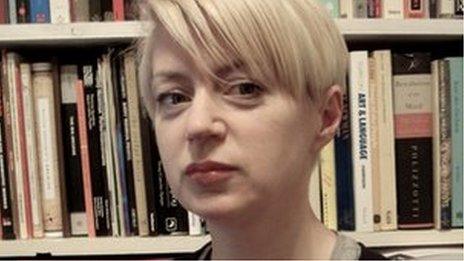Calling Art Names: Turner Prize 2012
- Published
The Bradford-born artist won £25,000 prize for work which included a film inspired by a fatal fire at a Woolworths store
I received an email this morning from a man who took exception to my use of the term 'installation' when describing the work of this year's Turner Prize-winning artist, Elizabeth Price on last night's News at Ten.
"It is a video…it can be screened by the BBC and ITV etc…it is not an installation in any way", he wrote.
I asked if he had he seen the work. No, he replied, he hadn't.
He should, I suggested. Not to prove a point, but because its worth a look and a listen. In my view, Elizabeth Price's The Woolworths Choir of 1979 is an effective and affecting work of art.
It is true that the video element could be played on a TV monitor, although its power would be greatly reduced. But there is more to the work than a 20-minute, fast-cut film that starts with architectural diagrams of medieval churches and ends with images of the fatal fire that began in the furniture store of a Woolworths shop in Manchester in the late 70s.
Price plays on the word 'choir' throughout the artwork. The video begins with the physical 'choir' area of a church, before moving onto the word's choral origins that are illustrated by harmonised voices from pop videos, which then leads to the harmonised accounts of people who were in, or witnessed, the Woolworths fire of 1979.
Staccato finger clicks and ritualistic handclaps are a constant refrain throughout: a relentless synchronised sound emitted from freestanding speakers in the darkened gallery in Tate Britain, marking flash edits and emphasising visual points.
Towards the end of the video you see archive footage of two men drawing on a plan of the Woolworths building, pinpointing the area in which the fire started. They outline the now familiar rectangular shape of a church choir, which instead of being packed with wooden seating, was piled high with flammable soft furnishings.
And all the time, perhaps without realising, you too are sitting on furniture that has been arranged in the form of a choir: a theme that is referenced once again by the design of the gallery's back wall.
I stand by the term 'installation', but the semantics of how it is described are not terribly important, it is the semantics around which Elizabeth Price has built her thoughtful work of art that matter.
And, like almost all art, it can only be properly appreciated by seeing, hearing and experiencing it first hand.
- Published4 December 2012

- Published3 December 2012
